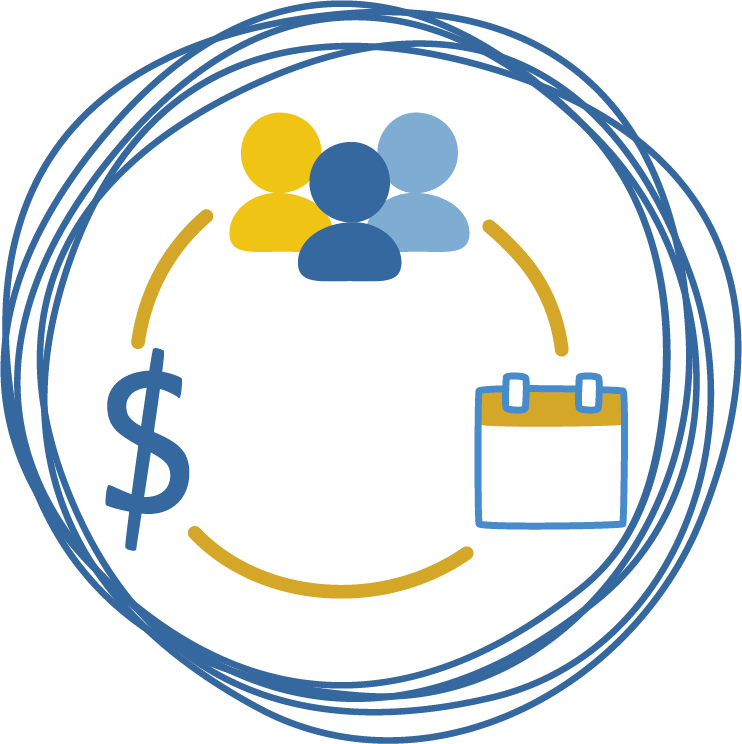Complex projects almost always require a collaborative approach with multiple colleagues and stakeholders, often with disparate skills and backgrounds, working together towards a common goal. Effective collaboration involves preparation, infrastructure, and skills geared towards team functioning. Success will take practice and dedication. You won’t get there overnight. This method will help your team host an initial discussion to set basic expectations around collaboration and start down the path towards team effectiveness.
Design Phase: Include
Facilitator: 1
Activity Group: 4-8
Time: 30 Min
Materials: Sticky notes and markers, Whiteboard Virtual Whiteboard

Before the Activity
A good time to use this method is when a new team is forming to kick off a project or achieve a goal. This method can also be used with an existing team that is looking to reset expectations or work together more effectively.
During the Activity
Begin by convening all essential colleagues and stakeholders that will form the core of your working collaboration.
This activity is generally run as an open discussion among team members around several prompt questions. Rather than dictating answers to each prompt, we recommend striving for input and consensus by asking team members to each respond to the question, perhaps silently using a sticky note, and then sharing their responses so that you hear from every member before you launch your discussion. If you see potential areas of tension among the answers you can use methods such as Affinity Mapping or Dot Voting to help build consensus.
Here are essential discussions to cover in the activity:
Goals
What are we trying to achieve? What is our goal and subgoals? Is each individual committed to the goal? Do we all see our part in achieving the goal?
Communication and Coordination
How will we communicate and coordinate? What is our communication style? What platforms and channels will we use? How often will we meet and for what purpose?
Roles
What role will each team member take on? Do we have gaps in roles or skills on our team? Using the Personal Dashboard can help your team understand each others’ experience, skills, needs, and desires.
Technology and Data
What data and technology will we rely on to do our work? To coordinate our work? To communicate? Do we need assistance or training to ensure we can effectively use these resources?
Decision Making
How will we make decisions? Via consensus? Democratically? Will a leader or steering committee make final decisions? How will decisions be recorded and made known?
Assessment and Quality Improvement
How will we measure the performance of our team and the quality of our work over time? What will we do to maintain and enhance quality? Where will we track progress and how will we make progress known?
After the Activity
Collaborative effectiveness involves many components and skills. Depending on the needs and desires of your team, there are several pathways available that can help your team work together better. Here are a few:
Personal Dashboard
The personal dashboard is an activity that can help your teams understand each others’ experience, skills, needs, and desires.
Conflict Resolution
Teams of any size eventually experience conflict. How the team deals with conflict can have a large impact on team effectiveness. Developing effective strategies and systems for preventing and managing conflict are essential. Triad Consulting’s “Difficult Conversations” framework is a method that works well for many situations.
Self-Awareness and Emotional Intelligence
Greater control over your own emotional reactions can improve the quality of interactions. Assessments such as Meyers-Briggs or DiSC can help you build awareness of your own personality traits.
- Leadership Training
Both new leaders and experienced leaders should have a defined approach to managing the work and output of a team. There are many approaches to leadership. Often the most successful leadership method is a combination of approaches appropriate to the context. - Ground Rules
Often, core expectations for team interactions go unsaid. Developing a set of ground rules for your team can ensure everyone is on the same page. - Developing a Shared Vision
For some types of teams (e.g., academic or scientific research teams), developing a compelling shared vision is essential to continued commitment. The Headline Activity offers a way to start this discussion.
